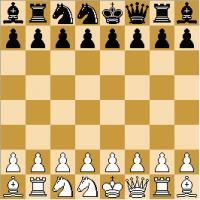
Fischer Random Chess
Since Bobby Fischer died on January 17 much has been written about him because much was accomplished by his genius. One of his legacies is a chess variant called “Fischer Random Chess” (FRC), which he created in 1996. Another common name for this variant is “Chess960” since there are 960 different ways that the board can be set up. The back rank pieces are set up at random, subject to a few constraints, as we will see.
The purpose of all forms of random chess is to nullify the influence of opening theory under the assumption that there are too many opening configurations to make any kind of opening study feasible.
Fischer believed that rote memorization of opening lines is an adulteration of the purity of mental battle. Stripping the players from their accoutrements of opening theory allows them to do battle armed only with their naked skill, much as the Greeks struggled naked during the ancient games.
To begin an FRC game, you set up the pawns in their normal positions on the 2nd and 7th ranks. The white pieces are then placed randomly on the first rank within the following constraints:
(a) The King is placed between the two rooks.
(b) The Bishops are placed on opposite colors.
After the White pieces are ready, the Black pieces are set up on the 8th rank exactly opposite their White counterparts. Just as in orthodox chess, the Queens, Knights, Bishops and Rooks are all on the same files opposing each other.

There are also rules for castling, since the Rooks and the King may or may not be found on their ‘normal’ squares as in orthodox chess. These rules will be familiar because, in the FRC opening configuration that just happens to be the same one as in orthodox chess, they give identical results as the castling rules for standard chess.
(i) The King and Rook move to the identical destination squares as in orthodox chess. It’s just that their starting positions may be
quite different from orthochess.
(ii) Neither the King nor the Rook is allowed to move before castling.
(iii) No square between the King and Rook, nor the initial or final destination squares of the King may be attacked by an opposing piece or pawn.
(iv) There can only be empty squares between the King’s initial and destination squares, and there can only be empty squares between the Rook’s initial and destination squares.
(v) The King’s destination square must also be vacant.
Other than these special rules, the rules for FRC are identical with orthodox chess, and any standard chess set may be used.
You can find software on the web that will automatically create a legal Fischer Random opening position, and there is a nice manual procedure that you can use when you are not connected to the web.
If you wish to play FRC and you cannot find anyone at the local chess club to play, you can join the FRC Email Club, and for the more serious, there are even tournaments for this variant. The first FRC tournament was won by GM Péter Lékó of Hungary in 1996, and Lékó also became the first FRC World Champion in 2001 when he defeated GM Michael Adams.
You may not play FRC as well as Bobby, but then how many of us play orthochess as well as he did?


